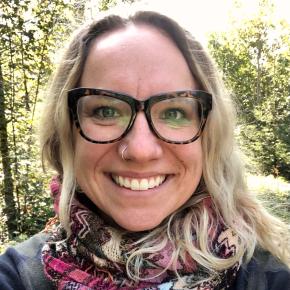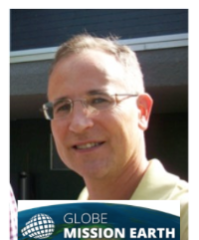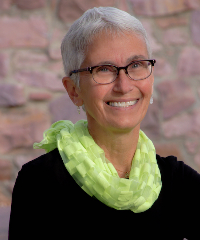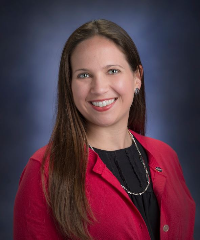Community Blogs
Community Blogs
Discover how the GLOBE community is engaging in all things GLOBE through the community blog posts below.
Learn how to create a GLOBE community blog post.
Filter By:
Blogs List
Blog Contributors: Denise "Skye" Yost - GIO and Matthew Rodell - NASA
World Water Day (WWD) is right around the corner on 22 March 2022! WWD began in 1993 by the United Nations to celebrate freshwater, and bring awareness to use and conservation of freshwater resources across the globe.
This year, the theme for WWD is Groundwater. Groundwater is often misunderstood because it is not seen easily, unlike rivers, lakes, ponds, or oceans. But, groundwater plays a very important role in freshwater sources, specifically in providing moisture for plants to grow, and water for animals ...
Read More »
Posted in:
Curriculum:
STEM
GLOBE Science Topics:
DATA INCLUDED
GLOBE PROTOCOLS
EARTH AS A SYSTEM
Learning Activities:
EARTH AS A SYSTEM
HYDROLOGY
LAND COVER/BIOLOGY
SOIL
The Urban Heat Island Effect Intensive Observation Period (IOP) has started. The weather in the Northern Hemisphere has started to get warmer as meteorological spring started March 1. There was an amazing weather situation where I live this past Saturday. You can see in the images on the left that I drove about 20 miles (32 km) from my house in Michigan to the Oak Openings Park in Ohio. There is a warm front stalled across the area.
It was near 40 F (6 C) near my house but in the upper 60s (20 C) at the park. You can see in the right image that there was a warm front between my house ...
Posted in:
I thought October 5, 2021, would be a normal day. I sat in a diner with my family after school, scrolling through my email and sipping a mint chocolate chip milkshake. It had been two months since my NASA STEM Enhancement in Earth Science (SEES) internship ended– or so I thought.
Suddenly, I received an intriguing email. The subject line read, “AGU Fall Meeting 2021 Abstract Status Notification.” I had forgotten that my Mosquito Mapping team submitted an abstract in the first place. Taking a break from my milkshake, I curiously opened the email:
“On behalf of the AGU Fall Meeting ...
Posted in:
In the Toledo area, Dr. C and schools in the area focused on studying artificial turf versus grass soccer and football fields. Artificial turf was much warmer than natural grass. This is combining the GLOBE Urban Heat Island Field Study with research by Vasco Mantas from the University of Coimbra in Portugal and George Xian from the USGS Eros Data Center and the AREN Project with Andy Henry and Geoff Bland.
University of Toledo students using the AREN TerraROVER on the UT football field.
You can see that the artificial turf of the football field (called the Glass Bowl) and the ...
Posted in:
Field Campaigns:
SURFACE TEMPERATURE
Investigation Areas:
SURFACE TEMPERATURE
Student Research Reports:
U.S. STUDENT RESEARCH SYMPOSIA (SRS)
MISSION EARTH REPORT
During the SEES internship, I got the opportunity to do data collection fieldwork. This required me to go around my neighborhood and take pictures of specific points that had been calculated using a Python notebook. Some of these points were in parts of my neighborhood that I’d never been to, despite being in my fourteenth year of living there. I even saw a pack of wild javelinas in a particularly remote spot! The task definitely took longer than I expected, but it felt good to know that I had contributed data that would actually help NASA scientists.
I also got to brainstorm my ...
Posted in:
Investigation Areas:
EARTH AS A SYSTEM
MOSQUITOES
Primary Audience:
STUDENTS
TEACHERS
Student Research Reports:
INTERNATIONAL VIRTUAL SCIENCE SYMPOSIUM REPORT
MISSION MOSQUITO REPORT
Did you know that clouds can both warm and cool our planet? Keeping an eye on clouds helps NASA study our climate. You can notice some of these changes by just looking at the clouds.
Here are some examples you might have already noticed:
Do all clouds cast shadows? Low thick clouds tend to cast the most shadows. The shadows show you how the cloud is blocking the light from the sun from reaching the ground. This is similar to you placing your hand in front of your eyes when it is too sunny. Your hand is blocking the light from reaching your eyes. This is the same as the ...
Posted in:
Curriculum:
SCIENCE AND MATH
STEM
GLOBE Science Topics:
BACKYARD SCIENCE
CLIMATE
CLIMATE CHANGE
GENERAL SCIENCE
GLOBE PROTOCOLS
EARTH AS A SYSTEM
SCIENTIST SKILLS
Investigation Areas:
ATMOSPHERE
Primary Audience:
ALUMNI
COUNTRY COORDINATORS
PARTNERS
SCIENTISTS
STUDENTS
TEACHERS
TRAINERS
The weather has been really kicking up quite a bit of whacky weather in November. On November 2, 2021, the town of Kikonai in northern Japan’s Kokkaido prefecture set a record amount of rainfall of 2.2 inches (5.5 centimeters) in 10 minutes. Wow!! That’s a lot of rain in a short amount of time! You can see where the rainfall fell on the image below!
(credit: Extreme weather around the world amid COP26 - The Washington Post )
Meanwhile in Uzbekistan, it saw the worst dust storm in about 50 years! The dust finally settled on November 4, 2021 but ...
Posted in:
Investigation Areas:
ATMOSPHERE
EARTH AS A SYSTEM
Image Credit: Jenn Glaser, ScribeArts
If the last mosquito season felt longer, or if mosquito bites seemed to hurt more than you remembered, you didn’t imagine it! Mosquitoes respond sensitively to changes in heat, humidity, and precipitation, and serve as buzzy, annoying sentinels of our changing climate. Here’s how mosquitoes are letting us know our climate is changing.
With climate change comes an increased frequency and intensity of extreme weather events -- think of this summer’s historic heat dome in the Pacific Northwest, the wildfires in the western ...
Posted in:
Coming into the NASA SEES Internship, I had only ever experienced science through a
one-dimensional lens. I always knew the results, experimenting just to prove existing
knowledge. This internship taught me to look outside the box and challenge my preconceived
notions to discover new relationships that exist on our earth.
Through our weekly meetings, I got to interact with guest speakers and my mentors who were
taking on various projects in the field of epidemiology. Inspired by one such meeting where Dr.
Chellappan used machine learning to predict the mosquito species in an ...
Posted in:
Stratus clouds are one of the three main types of clouds. Remember that there are many types of clouds that fall into three main categories: cumulus, stratus, and cirrus. Using hand-motions , we would stretch out our hands as far out as we could to mimic a stratus cloud. There are stratus-type clouds at all three basic altitude levels. These are: stratus clouds (low level), altostratus clouds (mid level), and cirrostratus clouds (high level). When stratus-type clouds are present, your skies will most likely be overcast or the cloud cover is 90% or more. Note, there is a ...
Posted in:
Curriculum:
SCIENCE AND MATH
STEM
GLOBE Science Topics:
GENERAL SCIENCE
GLOBE PROTOCOLS
Investigation Areas:
ATMOSPHERE
EARTH AS A SYSTEM
Primary Audience:
ALUMNI
COUNTRY COORDINATORS
PARTNERS
STUDENTS
TEACHERS
TRAINERS
Have you ever wondered how NASA develops accurate models of the earth's surface from space? How do we know the topography of the planet, the behavior of the water cycle, or the changes to sea level? My experience with the NASA SEES Earth System Explorers virtual internship this summer gave me a glimpse into the process of how such data is collected, analyzed, and ultimately presented: remote sensing. The internship allowed me to empirically learn about the world around me through a combination of coursework, literature review, hands-on science, and collaborative research.
In ...
Posted in:
Have you heard there is a new clouds project? It is called NASA GLOBE CLOUD GAZE. It is a merger of GLOBE Clouds and The Zooniverse online citizen science platform. A one-week pacing guide is now available!
Sky photographs are one of the most requested portions of a GLOBE Clouds observation. This is because there is so much you can do with them. Photographs give scientists the opportunity to be right there with you. Details within a photograph can be used to compare with satellite data, confirm dust or haze observations, and give insight to unique cloud types like ...
Posted in:
Curriculum:
SCIENCE AND MATH
STEM
GLOBE Science Topics:
BACKYARD SCIENCE
CLIMATE
CLIMATE CHANGE
DATA INCLUDED
GENERAL SCIENCE
GLOBE PROTOCOLS
EARTH SYSTEM SCIENCE
Investigation Areas:
ATMOSPHERE
Learning Activities:
ATMOSPHERE AND CLIMATE
News Topics:
NEWS BRIEFS
Primary Audience:
ALUMNI
COUNTRY COORDINATORS
PARTNERS
SCIENTISTS
STUDENTS
TEACHERS
TRAINERS
After digging through my sea of emails, I remember the thrill I felt when I received my acceptance into the NASA SEES Internship Earth Explorers- Mosquito Mappers. Realizing this would be the first time I experienced a program remotely, my mind raced with questions. What will it be like, being part of a research team? What if I mess up the registration process? What would research look like? Although I wasn’t sure what to expect of the program, I was eager to discover what experiences and challenges await.
The first task was to collect mosquito samples. Never did I expect such a ...
Posted in:
Investigation Areas:
MOSQUITOES
Background
Remote working and remote learning presented challenges to us all. As a Master Trainer in Colombia, Juan Felipe Restrepo Mesa faced and overcame his share of challenges when working with a new group of educators from rural areas. Most of the training material and the tests that need to be answered were in English. This, of course, means that citizen scientists who do not speak English were prevented from making their contributions living in those areas where GLOBE Observer Mosquito Habitat Mapper's contributions are essential.
Juan Felipe had to set up a MEET ...
Posted in:
Diversity, Equity, and Inclusion:
DIVERSITY, EQUITY, AND INCLUSION
GLOBE Science Topics:
EARTH AS A SYSTEM
EARTH SYSTEM SCIENCE
Investigation Areas:
HYDROSPHERE
LAND COVER CLASSIFICATION
MOSQUITOES
Primary Audience:
COUNTRY COORDINATORS
PARTNERS
SCIENTISTS
TEACHERS
TRAINERS
I was excited when I heard that I got a second opportunity to participate in the NASA SEES internship. I was fortunate to be selected last year too. But when I found out that I was placed on the Mosquito Mapper team, initially I was a bit disappointed that I did not get my preferred choice. But I went in with an open mind.
In both years, the internship falls during my school year because in India summer break ends in May. But what made it more challenging this year compared to last year is that I had exams, I was selected to represent India in the prestigious International Linguistics ...
Posted in:
Co-author and GLOBE Observer scientist Dr. Rusty Low (right) with co-author, Anita Schiller (left), Director, Biological Control Initiative, Harris County, TX, Precinct 4. “We encourage you to conduct your own local mosquito “expedition” and submit photos during the Mosquito Habitat Photo Challenge.“ More details on the challenge are further below. Rusty: When we told our friends we were going to Tucson, Arizona to look for a specific mosquito, they didn’t believe us. How could mosquitoes thrive in a hot, dry desert? Well, they can’t, but not all of southeastern Arizona is ...
Posted in:
The GLOBE Mosquito Habitat Photo Challenge kicked off Sunday, July 25 and continues through August 25, 2021. This challenge combines Mosquito Habitat Mapper and Land Cover (two GLOBE Observer app tools) to document areas with and without mosquito breeding habitats using only photos. A picture could be worth a thousand words. But can we use computers to tell us which words describe the content of photos? Your photo contributions could help us answer this question while supporting new NASA research projects. A Computer Must Be Trained To See There has ...
Posted in:
Have you ever wondered what happens after you submit your GLOBE Observer data? Citizen science data has many applications and is also incredibly important for scientists who are working in the field of artificial intelligence (AI). This is because citizen science observations are an effective way to obtain the tens of thousands of photos needed to train, validate, and test predictive models developed using machine learning. This puts the photos that you upload using the Mosquito Habitat Mapper and Land Cover tools at the cutting edge of computational science research. There ...
Posted in:
At the start of the month, i was invited by SAASTA, a body in South Africa that promotes science in schools to train teachers in 4 districts in 4 days in Mpumalanga. It took me 5hrs of drive from Pretoria to my first venue of training where 40 teachers from different schools welcomed us. Later on we proceeded to two other districts where at least 40 teachers at each venue were introduced to GLOBE, trained in two Atmospheric protocols, how to navigate the website, enter data and shown how to use the GLOBE observer App. The six hour day training empahasised the importance of intergrating ...
Posted in:
GLOBE Working Groups:
EDUCATION WORKING GROUP
Primary Audience:
TRAINERS
Hi! My name is Om, and I'm a high school junior. This summer, I participated in the SEES Internship Program a partnership with UT Austin and NASA, and worked with the Mosquito Mapper cohort. The goal of the Mosquito Mappers is to collect mosquito larva, analyze this data, and draw conclusions about mosquitoes and their land cover habitats. I started the internship in early June with an introductory webinar where I met scientists, mentors, peer mentors, and more. I gained an overview of the expectations and outcomes that I would strive for during the following months. The goal of the ...
Posted in:
—
20 Items per Page










